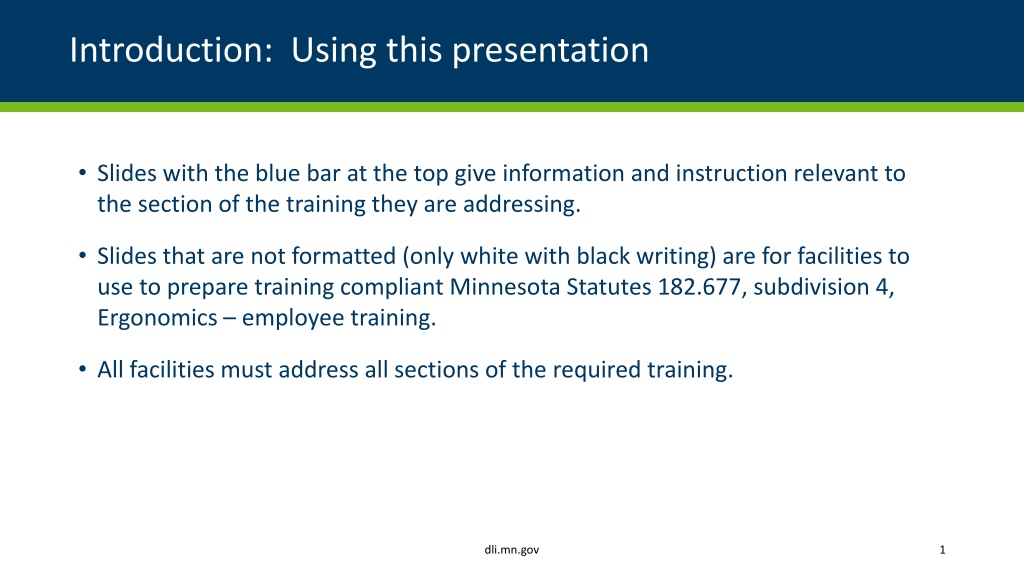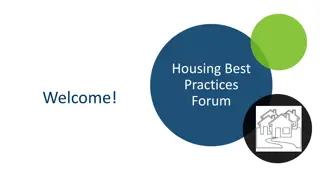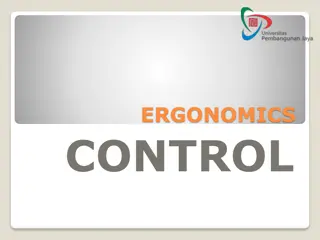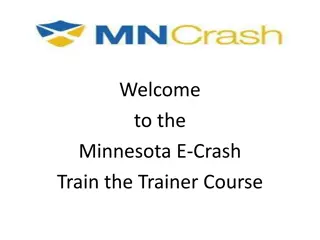Ergonomics Training Requirements for Minnesota Employers
Employers in Minnesota must comply with statutory training requirements related to ergonomics and safety committees. Training covers topics such as safety committee establishment, ergonomics programs, reporting procedures for injuries, and controls for ergonomic hazards. Non-compliance may result in citations and penalties as outlined in Minnesota Statutes. Additional requirements for warehouse distribution centers are also highlighted.
Download Presentation

Please find below an Image/Link to download the presentation.
The content on the website is provided AS IS for your information and personal use only. It may not be sold, licensed, or shared on other websites without obtaining consent from the author. Download presentation by click this link. If you encounter any issues during the download, it is possible that the publisher has removed the file from their server.
E N D
Presentation Transcript
Introduction: Using this presentation Slides with the blue bar at the top give information and instruction relevant to the section of the training they are addressing. Slides that are not formatted (only white with black writing) are for facilities to use to prepare training compliant Minnesota Statutes 182.677, subdivision 4, Ergonomics employee training. All facilities must address all sections of the required training. dli.mn.gov 1
Ergonomics employee training Minnesota Statutes 182.677, subdivision 4 Minnesota OSHA Compliance | Department of Labor and Industry dli.mn.gov
Training requirements An employer subject to this section must train all employees about the following: 1) the name of each individual on the employer s safety committee; 2) the facility s ergonomics program; 3) the early signs and symptoms of musculoskeletal injuries and the procedures for reporting them; 4) the procedures for reporting injuries and other hazards; 5) any administrative or engineering controls related to ergonomic hazards that are in place or will be implemented; and 6) the requirements of Minn. Stat. 182.677, subd. 9. dli.mn.gov 4
Minn. Stat. 182.676, Safety committees a) Every public or private employer of more than 25 employees shall establish and administer a joint labor-management safety committee. b) Every public or private employer of 25 or fewer employees shall establish and administer a safety committee if: it is subject to the requirements of Minn. Stat. 182.653, subd. 8. dli.mn.gov 5
Minn. Stat. 182.676, Safety committees, continued c) A safety committee must hold regularly scheduled meetings unless otherwise provided in a collective bargaining agreement. d) Employee safety committee members must be selected by employees. An employer that fails to establish or administer a safety committee as required by this section may be cited by the commissioner. A citation is punishable as a serious violation under section 182.666. See revisor.mn.gov/statutes/cite/182.676. dli.mn.gov 6
Warehouse distribution centers: Additional safety committee requirements The employer must hold monthly as provided under Minn. Stat. 182.676, until for two consecutive years the worksite or the employer does not have an employee incidence rate 30% higher than the average yearly incidence rate for the relevant North American Industry Classification System (NAICS) code. dli.mn.gov 7
Individual NAICS codes in the 30%-over category Incident rate that is 30% higher than average where safety committees are required Employee incidence rate (2021) Industry 493110 for General Warehousing and Storage 5.6 7.28 423 for Merchant Wholesalers, Durable Goods 2.1 2.73 424 for Merchant Wholesalers, Nondurable Goods 3.5 4.55 454110 for Electronic Shopping and Mail-order Houses 1.4 1.82 492110 for Couriers and Express Delivery Services 8 10.4 dli.mn.gov 8
Meat processing facilities: Additional committee requirements Additional requirements for meatpacking facility committees Refer to Minn. Stat. 179.876 for requirements at revisor.mn.gov/statutes/cite/179.876 dli.mn.gov 9
Safety committee members [Name each individual on the safety committee.] [List name and job title]
Safety committee members, continued [For meatpacking, add the following members.] [A certified professional ergonomist (CPE).] [A licensed, board-certified physician, with preference given to a physician who has specialized experience and training in occupational medicine.] [At least three workers employed in the employer s facility who have completed a general industry outreach course approved by the commissioner, one of whom must be an authorized employee representative if the employer is party to a collective bargaining agreement.] 11
Safety committee members, continued For health care, add the following members.] [List the members of the safe-patient-handling committee.] 12
Ergonomics program required An ergonomics program is a systematic process for identifying, analyzing and controlling workplace risk factors, often for reducing musculoskeletal disorders. The program shall include: 1) an assessment to identify and reduce musculoskeletal disorder risk factors in the facility; 2) an initial and ongoing training of employees on ergonomics and its benefits, including the importance of reporting early symptoms of musculoskeletal disorders; 3) a procedure to ensure early reporting of musculoskeletal disorders to prevent or reduce the progression of symptoms, the development of serious injuries and lost- time claims;
Ergonomics program required, continued 4) a process for employees to provide possible solutions that may be implemented to reduce, control or eliminate workplace musculoskeletal disorders; 5) procedures to ensure that physical plant modifications and major construction projects are consistent with program goals; and 6) annual evaluations of the ergonomics program and whenever a change to the work process occurs.
Ergonomics program resource An ergonomics program is a systematic process for identifying, analyzing and controlling workplace risk factors, often for reducing musculoskeletal disorders. The National Institute for Occupational Safety and Health (NIOSH) has created a site to assist in designing an effective ergonomics program to prevent work- related musculoskeletal disorders. Visit cdc.gov/niosh/topics/ergonomics/ergoprimer for more information.
NIOSH: Elements of ergonomics programs Step 1: Identify risk factors Step 5: Evaluate your ergonomics program Step 2: Involve and train management and workers Step 6: Promote worker recovery through health care management and return-to-work Step 3: Collect health and medical evidence Step 7: Maintain management commitment and employee involvement Step 4: Implement your ergonomics program dli.mn.gov 16
[This facilitys] ergonomics program [Detail each of the following about how the facility s ergonomics program works.] 1. An assessment to identify and reduce musculoskeletal disorder risk factors in the facility 2. An initial and ongoing training of employees about ergonomics and its benefits, including the importance of reporting early symptoms of musculoskeletal disorders 3. A procedure to ensure early reporting of musculoskeletal disorders to prevent or reduce the progression of symptoms, the development of serious injuries and lost-time claims
[This facilitys] ergonomics program, continued [Detail each of the following about how the facility s ergonomics program works.] 4. A process for employees to provide possible solutions that may be implemented to reduce, control or eliminate workplace musculoskeletal disorders 5. Procedures to ensure physical plant modifications and major construction projects are consistent with program goals 6. Annual evaluations of the ergonomics program and whenever a change to the work process occurs 7. How to access the facility s ergonomics program
Health care NAICS codes For health care facilities, safe patient-handling is a major risk factor for musculoskeletal injuries and illnesses. Requirements for safe patient-handling are contained in Minn. Stat. 182.6553. For more information, visit the MNOSHA WSC: Safe patient-handling webpage. dli.mn.gov 19
Reporting injuries and other hazards Comprehensive injury reporting is important to the success of an ergonomics process. The goal of this effort is to properly assess, diagnose and treat musculoskeletal disorders. Early reporting, diagnosis and intervention can limit injury severity, improve the effectiveness of treatment, minimize the likelihood of disability or permanent damage and reduce workers compensation claims. This will allow the employer to correctly identify work areas or specific tasks where injuries frequently occur or are most severe. This information helps direct the activities of the ergonomics team, as well as guide health care providers in making return-to-work and light-duty work decisions. Federal OSHA s injury and illness recording and reporting regulation (29 CFR Part 1904) requires employers to record and report work-related fatalities, injuries and illnesses. dli.mn.gov 20
Early reporting of signs, symptoms of MSDs Encouraging and using reports of musculoskeletal disorder (MSD) symptoms: reinforces worker training about recognizing MSD symptoms; encourages early reporting of MSD symptoms; allows for prompt medical evaluations for diagnosis, treatment and follow-up care; reduces injury severity, the number of workers compensation claims and associated costs, and the likelihood of permanent disability; provides guidance about return-to-work and work-placement restrictions during the healing process;
Early reporting of signs, symptoms of MSDs, continued guides job modifications; provides a mechanism to track and trend MSD injuries; and enables assessment of the effectiveness of work changes.
MDS signs, symptoms may include Fatigue Numbness Soreness Stiffness Aches and pain (aching or sharp) Swelling Weakness Loss of coordination Discomfort Body parts falling asleep Tenderness Loss of strength Burning Loss of joint movement Tingling Trouble sleeping due to pain dli.mn.gov 23
MSD signs, symptoms may include Fatigue Numbness Soreness Stiffness Aches and pain (aching or sharp) Swelling Weakness Loss of coordination Discomfort Body parts falling asleep Tenderness Loss of strength Burning Loss of joint movement Tingling Trouble sleeping due to pain
OSHA recordkeeping requirements It is important to know there are requirements under 1904 for OSHA recordkeeping that you will need to consider when establishing or evaluating your procedures for reporting early signs and symptoms of musculoskeletal injuries. Some injuries or illnesses reported to you may reach the level of needing to be on the OSHA 300 log; others may not reach that level. It is essential you understand what makes an injury or illness recordable. OSHA recordkeeping also has an employee involvement aspect that must be addressed. dli.mn.gov 25
Basic requirement for OSHA recordkeeping Your employees and their representatives must be involved in the recordkeeping system in several ways. You must: inform each employee of how they are to report a work-related injury or illness to you; provide employees with the information described in paragraph (b)(1)(iii) of this section; and provide access to your injury and illness records for your employees and their representatives as described in paragraph (b)(2) of this section. See 1904.35(a) through 1904.35(a)(3) at osha.gov/laws- regs/regulations/standardnumber/1904/1904.35.
OSHA recordkeeping employee reporting of injuries, illnesses What must I do to ensure employees report work-related injuries and illnesses to me? You must establish a reasonable procedure for employees to report work-related injuries and illnesses promptly and accurately. A procedure is not reasonable if it would deter or discourage a reasonable employee from accurately reporting a workplace injury or illness. You must inform each employee of your procedure for reporting work-related injuries and illnesses. You must inform each employee: they have the right to report work-related injuries and illnesses; and dli.mn.gov 27
OSHA recordkeeping employee reporting of injuries, illnesses, continued employers are prohibited from discharging or discriminating against any employee for reporting work-related injuries or illnesses. You must not discharge or in any manner discriminate against any employee for reporting a work-related injury or illness. dli.mn.gov 28
Incentive programs Incentive programs may discourage reporting. Incentive programs are not banned by OSHA, but must be developed to not interfere with or discourage employee reporting. Guidance for development of incentive programs is included in the following standard interpretations: Clarification of OSHA s position on workplace safety incentive programs and post-incident drug testing under 29 C.F.R. 1904.35(b)(1)(iv); and Employer safety incentive and disincentive policies and practices. dli.mn.gov 29
Procedures for reporting early signs, symptoms MSDs [What should be reported?] [When should a hazard be reported?] [How should workers make reports?] [How will management respond to reports?] [What should workers expect after making a report?] [How will you make sure all workers understand the reporting process?] [How will you make it clear no worker will face retaliation for reporting?] [How might you recognize workers who identify and report hazards?] 30
Reporting other hazards What should be reported? Your system should encourage reporting of all types of safety and health concerns (injuries, illnesses, anticipated hazards from new processes or equipment, unsafe conditions or behaviors, close calls and near misses, hazards from non-routine tasks and potential emergencies, and weaknesses of your safety and health program). When should a hazard be reported? Your system should empower workers to report hazards immediately. Workers should also know they can stop any operation they believe to be unsafe. How should workers make reports? Think of options for workers to report to management verbally or in writing. If possible, give workers a way to report anonymously. dli.mn.gov 31
Reporting other hazards, continued How will management respond to reports? Make sure your system directs management to promptly acknowledge reports and begin an investigation. What should workers expect after making a report? Your process should involve regular communication about actions taken to address reported hazards. How will you make sure all workers understand the reporting process? Consider barriers such as language, literacy and internet access. How will you make it clear no worker will face retaliation for reporting? Make sure workers know you will only use reports to improve safety and health. How might you recognize workers who identify and report hazards? Consider a bonus, a gift certificate or a public thank you. dli.mn.gov 32
Reporting other hazards, continued How will you involve workers in finding solution to reported concerns? Your system should encourage workers to suggest ways to eliminate or control the hazard. This could be at the time of the report, after the report or both. This part of your system will be important when you begin work on hazard prevention and control. dli.mn.gov 33
Reporting other hazards A workplace hazard is any condition, activity or source that could, if left uncontrolled, lead to an injury or illness. Examples include: safety hazards slippery floors, broken ladder rungs, hot surfaces, machinery with moving parts, electrical hazards and confined spaces; health hazards chemicals, viruses, heat and noise; and other hazards stress, workplace violence, activities that cause wear and tear on the body, and assigning an untrained worker to a hazardous job. dli.mn.gov 34
Procedures for reporting other hazards [What should be reported?] [When should a hazard be reported?] [How should workers make reports?] [How will management respond to reports?] [What should workers expect after making a report?] [How will you make sure all workers understand the reporting process?] [How will you make it clear no worker will face retaliation for reporting?] [How might you recognize workers who identify and report hazards?] 35
Engineering controls To reduce the chance of injury, work tasks should be designed to limit exposure to ergonomic risk factors. Engineering controls implement physical changes to the workplace, which eliminates or reduces the hazard on the job or task and are the most desirable, where possible. Engineering controls include: automation; mechanization; lifting equipment; using a device to lift and reposition heavy objects to limit force exertion; reducing the weight of a load to limit force exertion; repositioning a worktable to eliminate a long or excessive reach and enable working in neutral postures;
Engineering controls, continued using diverging conveyors off a main line so tasks are less repetitive; installing diverters on conveyors to direct materials toward the worker to eliminate excessive leaning or reaching; and redesigning tools to enable neutral postures.
Engineering controls for ergonomic hazards, in place or to be implemented [Detail engineering controls for ergonomic hazards that are in place.] [Detail engineering controls for ergonomic hazards that will be implemented.]
Administrative controls establishing a lifting limit; Administrative controls establish work practices that reduce the duration, frequency or intensity of exposure to hazards. This may include: adjusting production rates; increasing staffing; work process training; maintaining tools; job rotation; reducing shift length or limiting the amount of overtime; job expansion; changing job rules and procedures, such as scheduling more breaks to allow for rest and recovery; ensuring adequate rest breaks; adjusting line speeds; dli.mn.gov 40
Administrative controls, continued training in the recognition of risk factors for MSDs and instructions in work practices and techniques that can ease the task demands or burden, such as stress and strain; establishing systems to rotate workers away from tasks to minimize the duration of continual exertion, repetitive motions and awkward postures; rotating workers through jobs that are physically tiring; staffing floaters to provide periodic breaks between scheduled breaks; and requiring heavy loads only be lifted by two people, to limit force exertion; properly using and maintaining pneumatic and power tools. dli.mn.gov 41
Administrative controls for ergonomic hazards, in place or to be implemented [Detail administrative controls for ergonomic hazards that are currently in place.] [Detail administrative controls for ergonomic hazards that will be implemented.]
Subd. 9, reporting encouraged Any employer subject to this section must not institute or maintain any program, policy or practices that discourages employees from reporting injuries, hazards, or safety and health standard violations, including ergonomic-related hazards and symptoms of musculoskeletal disorders. dli.mn.gov 43
Programs, policies, practices that may affect reporting Recommended practices for anti-retaliation programs provides recommendations and guidelines for preventing and addressing worker retaliation. OSHA directorate of whistleblower protection programs, 2017. Building a culture of safety discusses safety incentive programs based on leading and lagging indicators. OHS magazine, 2013. Designing a safety incentive program discusses building a balanced safety incentive program. NSC Safety and Health Magazine, 2012. OSHA memorandum on employer safety incentive and disincentive policies and practices describes types of safety incentive policies that might discourage dli.mn.gov 44
Programs, policies, practices that may affect reporting, continued reporting and constitute unlawful discrimination and a violation of section 11(c) and other whistleblower protection statutes. OSHA, 2012. OSHA report of injury and investigation forms provides sample injury and investigation forms. OSHA, undated. Safety leadership: Six important actions to move safety forward describes six actions that can be taken to help promote safety. Touches on several aspects of OSHA safety and health recommended practices. NSC Safety and Health Magazine, 2013. Small business handbook provides information to help small businesses meet the legal requirements imposed by the Occupational Safety and Health Act of 1970. OSHA, 2005. dli.mn.gov 45
Programs, policies, practices that may affect reporting, continued Near miss reporting systems explains the value of near-miss reporting and provides best-practice examples. NSC, 2013. Everybody gets to go home in one piece describes how near-miss reporting can prevent future injuries. NSC, 2012. dli.mn.gov 46
Reporting encouraged [Detail how reporting is encouraged at the facility.]
Training frequency New employees must be trained according to paragraph (a) prior to starting work. Current employees must receive initial training and ongoing annual training in accordance with the employer s ergonomics program. The employer must provide training during the working hours and compensate the employee for attending the training at the employer s standard rate of pay. All training must be in a language and with vocabulary the employee can understand.
Resource links bls.gov/web/osh/table-1-industry-rates-national.htm osha.gov/ergonomics/identify-problems#report-injuries dir.ca.gov/chswc/woshtep/iipp/materials/SB_Factsheet_H_ErgonomicHazards.pdf rmi.colostate.edu/ergonomics/injuries-and-injury-prevention/musculoskeletal- disorders-risk-factors-reporting/ osha.gov/laws-regs/regulations/standardnumber/1904/1904.35 osha.gov/sites/default/files/2_Reporting_Safety_And_Health_Concerns.pdf dli.mn.gov 49
Resource links, continued osha.gov/sites/default/files/1a_Review_Hazard_Information_From_Workers.pdf cdc.gov/niosh/topics/hierarchy cdc.gov/workplacehealthpromotion/health-strategies/musculoskeletal-disorders osha.gov/ergonomics/control-hazards cdc.gov/niosh/engcontrols osha.gov/safety-management/additional-resources-by-topic#reporting dli.mn.gov 50


























